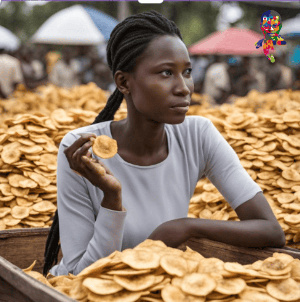BBC Pidgin of Thursday, 14 September 2023
Source: BBC
AI wey dem use to target children wit fake tori
Di BBC Global Disinformation team don find out say YouTube channels wey dey use AI to make videos wey include fake science information dem dey recommend di videos to children as "educational content".
We identify ova 50 channels for more dan 20 languages wey dey spread fake informate wey dem pose under STEM [Science Technology Engineering Maths] content.
Dem include pseudo-science, false information and conspiracy theories, such as electricity-producing pyramids, di denial of human-caused climate change and di existence of aliens.
Our analysis show YouTube recommend these "bad science" videos to children alongside legitimate educational content.
More clicks, more money
Kyle Hill na YouTuber and science educator wey get plenty young viewers. Im begin notice these videos wey dey pop up for im feed a couple of months ago.
E say im followers tell am about di recommended content wey look legitimate, but e dey full of fake information. E look like say dem dey steal and manipulate accurate content and ideas and dem dey promote am on di site.
Di videos focus on wild claims, wit flashy commentary, catchy titles and dramatic images to draw viewers in, as di more dem watch, di more revenue di channels go get from adverts for di screen. YouTube also dey benefit; dem dey take around 45% of video advertising revenue.
Di creators dey also tag dia videos as "educational content", wey mean say dem dey more likely to dey recommended to children.
"As a science man wey I be," E tok, "I dey take am personal. These channels don know di right thing to do to maximise views wit di least amount of effort."
How to verify di fakes ones
We find plenty of channels on YouTube wey dey produce dis type of material, for languages like Arabic, Russian, Spanish, and Thai.
Many of these channels get more than a million subscribers. These videos often get millions of views.
Di channel creators dey publish content sharp- sharp, most of dem dey post different videos every day. To fit do dis kain tin we speed, we suspect say dem dey use generative AI programs.
Dis na programs like Chat GPT and MidJourney wey fit create new content wen dem ask dem to (eg. 'one black cat wey dey wear a crown'), instead of searching di internet to find examples wey already exist.
To verify dis, we take videos from each channel and use AI detection tools and expert analysis to assess di probability say di footage, narration and script na AI dem use make am.
Our analysis show say most videos use AI to generate text and images, and to scrape and manipulate material from legitimate science videos. Di result: content appear to dey true, but mostly e no be true.
Reaching children
We wan see if these "bad science" videos go dey recommended to children, so we creat children accounts for di main YouTube site. (All di children we speak to say dem used dis rather than YouTube Kids.)
Afta four days of watching legitimate science education videos, dem suggest AI-made videos. If we click on dem, den dem go recommend more of these false-science channels.
We show some of di recommended content to two groups of 10-12-year-olds - one for UK and one for Thailand - to see if dem go believe wetin dem dey watch.
One video bin focus on discredited UFO and alien conspiracies. Di oda false informate bin claim say di Pyramids of Giza bin dey used to create electricity.
Our viewers bin dey convinced: "I enjoy to watch am," na wetin one girl tok, "For di beginning, I bin no dey sure say aliens dey exist, but now I feel na true."
Anoda pikin bin dey impressed by di electric pyramids: "I no know say pipo long ago go fit make electricity to use modern technology."
But some pipo bin fit pick out AI use for di videos: "E dey funny say dem even dey use human voice, I feel say no bin human," na so one pesin tok.
Wen we explain to dem say these videos dey AI-generated and contain fake information, dem shock: "I'm actually dey really confused. I bin feel na real," na so one boy tok. Another pesin tok: "I for believe am if to say you know tell us say na fake."
Children go likely believe fake informate
Educators say to play on pikin interest wit new style, fit confuse dem about wetin dey true.
"These videos dey do well becos dem dey conspiratorial," na so Professor Vicki Nash tok, Director of di Oxford Internet Institute.
All of us dey interested by tins wey dey run counter to officially wetin dem dey tell us, and children dey more open to dis dan adults."
Claire Seeley na primary school teacher for UK, and agrees: "Children go often take wetin dem see as fact first and foremost. N only maybe wen dem dey a little older, dem go start to ask question."
Professor Nash also questioned if platforms suppose to earn money from adverts wey dey come alongside di videos: "Di idea say YouTube and Google dey make money off di back of adverts wey dem serve wit pseudo-science news dey really unethical to me.
We bin contact a number of companies wey dey produce dis AI content. One respond, say dia content dey intended for "entertainment purposes". Dem deny say dem dey target children and add say dem no dey use AI "for majority" of dia scripts.
YouTube tell us say dem recommend YouTube Kids for under 13s, wey get a "higher bar" for videos wey dem fit show.
Dem say dem dey committed to removing misinformation from dia platforms and providing families wit a "safe and high-quality experience".
Dem also direct us to information panels wey dem say dey show additional context from third-party sources on conspiracy-related content. We find out say dem dey only present for a few of di videos across di 50 channels.
Dem no tok pim on top questions about advertising revenue wey dem fit dey collect from these videos.
Playing catch-up
As AI tools continue to improve, dis content go dey e easier to create and di quality of di videos go become more difficult to identify.
Teacher Claire Seeley dey worried. She say teachers and parents need to prepare for di threat: "We no really understand how AI-generated content dey really impact children's understanding.
As teachers, we dey play catch up to try to get to understand dis."
Entertainment













